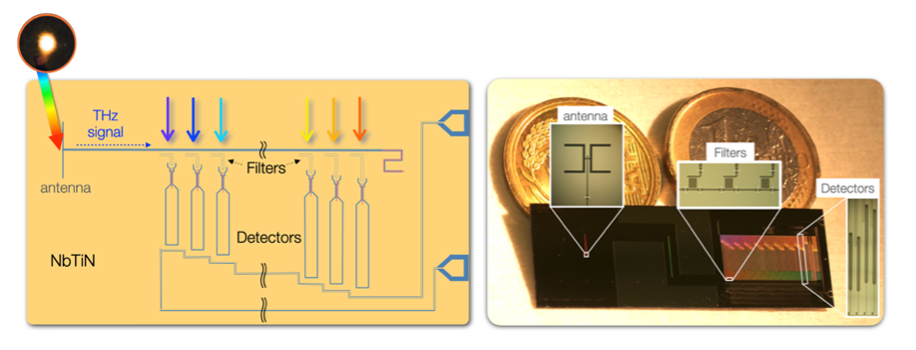Observations of the Universe at wavelengths between 0.3 – 3 mm allow us to study the cold and obscure universe. This type of radiation is emitted by cold objects such as gas and dust clouds.
Hidden in these clouds are the birth chambers of new planetary systems and even whole galaxies. Optical instrumentation cannot pierce through those clouds. Hence, the Universe looks completely different in the sub-mm than in the optical, as we see completely different objects.

Figure 1. Composite of a part of the optical Hubble deep field (in blue), overlayed with an ALMA image at 1.3 mm of the same field. Clearly, ALMA objects are invisible for Hubble, and vice versa.
Technology gap
Various cameras operate in the sub-mm, such as AMKID and SCUBA-2, as well as spectroscopic instruments such as ALMA and NOEMA. What is missing however, is a spectrometer with a large bandwidth, which is especially relevant when measuring objects outside of our own galaxy. Because of the expansion of the Universe, the wavelength of their radiation is stretched out, or redshifted. A narrow band spectrometer can easily miss a spectroscopic feature such as the emission line of a specific element like CO. Moreover, when measuring a few emission lines over a broad band we can retrieve the redshift, which is directly related to the distance of the object. Ultimately, a broad band spectrometer allows us to measure the distance of extra-galactic objects and thereby to create a 3D map of the universe. Other important applications are in cosmology as a broad band spectrometer is ideal to map the cosmic microwave background—the leftover radiation from the Big Bang.

Figure 2. By measuring the redshift of distance objects, using an on-chip spectrometer, turns a 2D map in a 3D model of the universe, along with the first light spectrum (top left). The DESHIMA instrument (top right) is deployed at the ASTE telescope.
Operation principle
Dispersive spectrometers with gratings or prisms become very large (~1 meter) at sub-mm wavelengths. To overcome this problem, SRON invented the on-chip spectrometer. This circuit, based on superconducting NbTiN films, couples to the broadband signal from a telescope, and divides it into narrow band sections using a set of filters. Each filter is connected to its own detector, so that each detector is sensitive only to a single wavelength. The first instrument, DESHIMA, was installed in 2016 on the ASTE telescope in Chile and successfully detected spectra from various sources. In 2023 the upgraded DESHIMA-2 was installed on the ASTE telescope, with even higher sensitivity and a larger bandwidth.
Figure 3. Principle of an on-chip spectrometer: radiation from space (THz signal) is coupled to an antenna, who sends it into a transmission line to a set of filters, each allowing only a limited bandwidth signal to a detector. A picture of the first realization of this concept, DESHIMA-1, is shown on the right.





